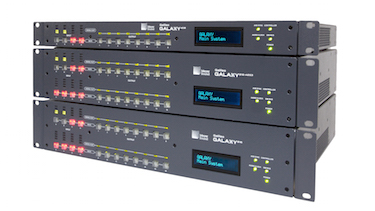One of the universal experiences of attending InfoComm is the many unplanned run-ins with a friendly industry colleague, swiftly followed by the obligatory “So what have you seen that’s cool?”
I find it a difficult question to answer, so I usually default to whatever I’ve seen most recently. This was the case the last day of the show upon such a rendezvous when I started to recap my demo of Meyer Sound’s new GALAXY processor. Without many specific details, I mentioned how there seemed to be a lot of new capabilities in the interface. This particular consultant friend of mine I was talking to knows and designs Meyer into many projects, and he brusquely passed it off as “oh, it’s just like Galileo with AVB.”
At which point, I fumbled an incoherent response attempting to articulate all of the dials and graphics and tools and drop downs I’d just witnessed. Ultimately, I judged this encounter a failure, but I realized that I had to get to the bottom of his question in terms of what were all of those shiny new features?
I recounted this story to Meyer Sound’s John McMahon, VP of solutions and strategy at Meyer Sound, who was kind enough to fill me in with the details.
My consultant friend may have been quick to judge, yet McMahon affirmed that Galaxy and the new version of Compass control software were designed to feel very familiar to existing Galileo users. Beyond the different colored front panel, it does have the same user experience and function, “but once you start peeling back the layers, there is a lot more functionality there,” McMahon explained. “Things like the delay matrix, that’s a huge step forward for doing complex system alignment that was just not possible before.”
And of course the AVB integration is there, so you could think of it as Galileo with AVB, but that version of the story is incomplete. Another area of design focus for the Meyer team was the U-Shaping equalization, which proved to be extremely popular in its previous applications. “On the [Galileo] Callisto, we only had the U-Shaping on the outputs, and the order of the filters was somewhat limited,” McMahon said. “With Galaxy, we’ve applied it to both the outputs and the inputs and increased the order or the steepness of some of the filters that are in there. It’s certainly more of the U-shaping filters, which people have absolutely fallen in love with because the contour and the EQ curves that you’re able to create are very intuitive and natural to how you would want to view the EQ, as opposed to some other filtering techniques.”
Beyond that, the phase integration was revamped, which addresses the different generations of Meyer loudspeakers produced over the years that have fallen into various phase categories in terms of response and how much phase correction that’s been done on them. With Galaxy, “the vast majority of our loudspeakers are now in the delay integration, so it makes it really easy to mix and match products over the years and have them stitch together seamlessly in terms of phase response, which is really quite important,” he said.
McMahon concluded by noting that there are a lot of other things coming for Galaxy down the road.
Lindsey Adler is editor of SCN. Follow her on Twitter, @lindseymadler.



